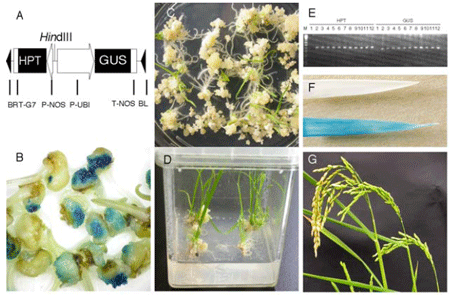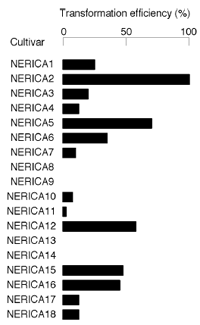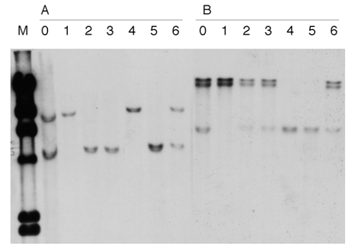Genetic transformation of NERICA by Agrobacterium method
Description
In 1992, the Africa Rice Center (WARDA) started work on interspecific hybridization between Oryza sativa L. and O. glaberrima Steud. in an attempt to combine the useful traits of both species. By 2005, 18 interspecific cultivars named “new rice for Africa” (NERICA), which are suitable for upland conditions, had been selected and disseminated to several African countries. These cultivars theoretically possess 12.5% of the O. glaberrima genome.
Genetic transformation has potential as a novel and powerful way to introduce desirable traits into target crops and to supplement traditional plant breeding techniques. Efficient protocols have been developed for transformation of japonica, indica and javanica cultivars. However, there had been no reports of genetic transformation of NERICA cultivars. This is the first demonstration of the genetic transformation of NERICA cultivars mediated by Agrobacterium.
Freshly isolated immature embryos were inoculated with A. tumefaciens LBA4404 that harbored binary vector pBIG-ubi::GUS, which carried a hygromycin-resistance gene and a GUS gene (Fig. 1A). GUS activity was observed in the inoculated immature embryos (Fig. 1B). Growth medium supplemented with 500 mg/l cefotaxime and 20 mg/l hygromycin was suitable for elimination of the bacteria and selection of transformed cells. Shoots regenerated from the selected cells on regeneration medium containing 250 mg/ cefotaxime and 20 mg/l hygromycin (Fig. 1C). The shoots developed roots on the hormone-free medium containing 30 mg/l hygromycin (Fig. 1D). Integration and expression of the transgenes were confirmed by PCR and histochemical GUS assay (Fig. 1E, 1F). Most of the plants were normal in terms of morphology and fertility (Fig. 1G). The transformation protocol produced stable transformants from 14 NERICA cultivars (Fig. 2). Inheritance and segregation of the transgenes were demonstrated by Southern blot analysis (Fig. 3). Now, NERICA, like other rice cultivars, can be improved by transgenic approaches.
Figure, table
-
Fig. 1 Production of transgenic NERICA mediated by Agrobacterium.
A) T-DNA region of pBIG-ubi::GUS; B) histochemical assays of GUS activity in immature embryos; C) regeneration of putatively transformed plants on regeneration medium with 20 mg/l hygromycin; D) growth of putative transformants on medium with 30 mg/l hygromycin. E) PCR analysis for the presence of the genes for HPT and GUS for putative transformants; F) GUS activity detected in the leaf of a transformed plant (lower) but no activity in a non-transformed plant (upper); G) a transformed plant grown in a greenhouse. -
Fig. 2 Transformation efficiency of 18 NERICA cultivars
(number of calli that differentiated shoots/number of inoculated immature embryos; %) -
Fig. 3 Southern blot analysis of T1 progeny produced by self-crossing of T0 plants
DNA was digested with HindIII, run in 0.8% agarose gel, transferred to a nylon membrane, and probed with peroxidase-labeled fragments containing a region of the hpt gene and a HindIII digest of lambda DNA. Lane 0, T0 plants; lanes 1-6, T1 plants
- Affiliation
-
Japan International Research Center for Agricultural Sciences Biological Resources Division
- Classification
-
Technical A
- Term of research
-
FY2007 (FY2006~2010)
- Responsible researcher
-
ISHIZAKI Takuma ( Biological Resources Division )
KUMASHIRO Takashi ( Biological Resources Division )
- ほか
- Publication, etc.
-
Ishizaki, T. and Kumashiro, T. Genetic transformation of NERICA, interspecific hybrid rice between Oryza glaberrima and O. sativa, mediated by Agrobacterium tumefaciens. Plant Cell Rep (2008) 27: 319-327.
Ishizaki, T. and Kumashiro, T. The 38th Annual Meeting of the Japanese Society of Plant Cell and Molecular Biology, 106.
- Japanese PDF
-
2007_seikajouhou_A4_ja_Part6.pdf577.55 KB



